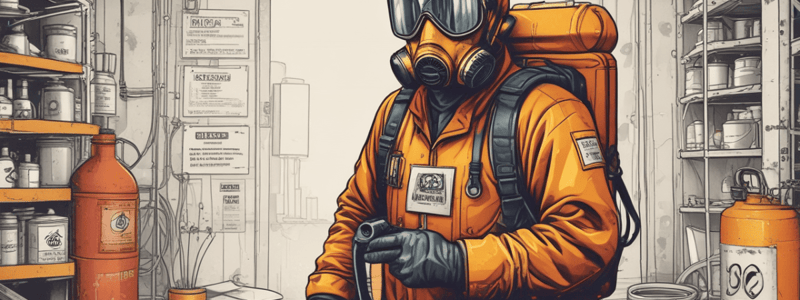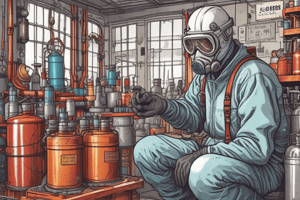Podcast
Questions and Answers
What is the primary purpose of WHMIS?
What is the primary purpose of WHMIS?
- To establish a standard format for hazard communication
- To protect employee health and safety by identifying and addressing risks associated with hazardous/controlled materials (correct)
- To classify and label hazardous materials globally
- To support the trade of chemicals for international exchange
What is the main goal of the Globally Harmonized System of Classification and Labelling of Chemicals (GHS)?
What is the main goal of the Globally Harmonized System of Classification and Labelling of Chemicals (GHS)?
- To create an internationally recognizable system for hazard communication (correct)
- To establish a standard format for hazard classification
- To support the trade of chemicals for international exchange
- To classify and label hazardous materials in Canada
What is included in the Workplace Hazardous Materials Information System (WHMIS)?
What is included in the Workplace Hazardous Materials Information System (WHMIS)?
- Classification of hazardous materials
- Labelling and safety data sheets
- Hazard identification and worker education
- All of the above (correct)
What is a controlled product in the context of WHMIS and GHS?
What is a controlled product in the context of WHMIS and GHS?
What is a pictogram in the context of GHS?
What is a pictogram in the context of GHS?
What is the primary purpose of GHS pictograms?
What is the primary purpose of GHS pictograms?
What is not a component of the Globally Harmonized System of Classification and Labelling of Chemicals (GHS)?
What is not a component of the Globally Harmonized System of Classification and Labelling of Chemicals (GHS)?
What is the main benefit of having a globally harmonized system for hazard communication?
What is the main benefit of having a globally harmonized system for hazard communication?
What is the role of the employer in WHMIS?
What is the role of the employer in WHMIS?
What are non-controlled products in the context of WHMIS and GHS?
What are non-controlled products in the context of WHMIS and GHS?
What is the primary purpose of a precautionary statement?
What is the primary purpose of a precautionary statement?
When is a workplace label not required?
When is a workplace label not required?
What information may be included on a supplemental label?
What information may be included on a supplemental label?
What is the 10th section of a Safety Data Sheet (SDS)?
What is the 10th section of a Safety Data Sheet (SDS)?
What is the purpose of a Safety Data Sheet (SDS)?
What is the purpose of a Safety Data Sheet (SDS)?
What is the 5th section of a Safety Data Sheet (SDS)?
What is the 5th section of a Safety Data Sheet (SDS)?
What type of products typically do not require a workplace label?
What type of products typically do not require a workplace label?
What information must be included on a workplace label?
What information must be included on a workplace label?
How many sections are there in a Safety Data Sheet (SDS)?
How many sections are there in a Safety Data Sheet (SDS)?
What is the 1st section of a Safety Data Sheet (SDS)?
What is the 1st section of a Safety Data Sheet (SDS)?
What is the purpose of the Hazard Pictograms in the GHS?
What is the purpose of the Hazard Pictograms in the GHS?
What is the responsibility of the supplier under WHMIS?
What is the responsibility of the supplier under WHMIS?
What type of information is found on a safety data sheet?
What type of information is found on a safety data sheet?
What is the purpose of the Environmental Hazard Pictograms?
What is the purpose of the Environmental Hazard Pictograms?
What type of pictograms are used for the transport of dangerous goods?
What type of pictograms are used for the transport of dangerous goods?
What is the responsibility of the employer under WHMIS?
What is the responsibility of the employer under WHMIS?
What is the purpose of a GHS label?
What is the purpose of a GHS label?
What type of information must be included on a supplier label?
What type of information must be included on a supplier label?
What is the purpose of the biohazardous infectious materials pictogram?
What is the purpose of the biohazardous infectious materials pictogram?
What is the role of the worker in regards to safety data sheets?
What is the role of the worker in regards to safety data sheets?
Study Notes
WHMIS and GHS
- WHMIS (Workplace Hazardous Materials Information System) is a Canadian federal legislation that aims to protect employee health and safety by identifying and addressing risks associated with hazardous materials.
- GHS (Globally Harmonized System of Classification and Labelling of Chemicals) is an internationally recognized system that defines and classifies the hazards of chemical products and communicates health and safety information on labels and safety data sheets.
Key Components of GHS
- Hazard identification
- Product classification
- Labelling
- Safety data sheets
- Worker education and training
Controlled and Non-Controlled Products
- Controlled products are substances that can be classified into one or more of the nine GHS hazard classes.
- Non-controlled products include radioactive materials, domestic products, cosmetics, food, and drug additives.
GHS Pictograms
- Hazard pictograms form part of the GHS and are used to convey specific information on labels and safety data sheets.
- There are two sets of pictograms: one for labelling containers and workplace hazard warnings, and another for transporting dangerous goods.
- Three categories of labels:
- Physical Hazards
- Health Hazards
- Environmental Hazards
GHS Hazard Pictograms
- Physical Hazards:
- Explosives
- Flammable
- Oxidizers
- Compressed gases
- Corrosive materials
- Health Hazards:
- Toxic substances
- Chronic health issues
- Skin and respiratory sensitization or carcinogenicity
- Environmental Hazards:
- Acute and chronic hazards to the aquatic environment
Duties and Responsibilities
- The Supplier:
- Responsible for classifying controlled products
- Ensuring required tests are carried out on controlled products
- The Employer:
- Ensuring employees are instructed on safety data sheets and their significance
- The Worker:
- Not responsible for producing safety data sheets, but plays a role in providing information on safety data sheets at the job site
WHMIS Labels and GHS
- A GHS label is a source of information about a controlled product, attached to the product or its container.
- Labels can take various forms (mark, sign, seal, stamp, device, tag, or wrapper).
- Supplier labels must be written in English and French.
- Workplace labels are required when a hazardous chemical is transferred to a secondary container for more than one day or if multiple individuals will have access to it.
Safety Data Sheets (SDS)
- 16 sections of information:
- Identification
- Hazard pictograms
- Composition/ingredients
- First aid measures
- Firefighting measures
- Accidental release measures
- Handling and storage
- Exposure controls (PPE)
- Physical and chemical properties
- Stability
- Toxicology
- Ecological information
- Disposal
- Transport information
- Regulatory information
- Other information
Studying That Suits You
Use AI to generate personalized quizzes and flashcards to suit your learning preferences.
Description
Test your knowledge of WHMIS and GHS, two systems that ensure employee safety by identifying and addressing risks associated with hazardous materials.




